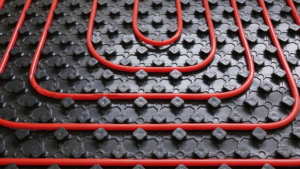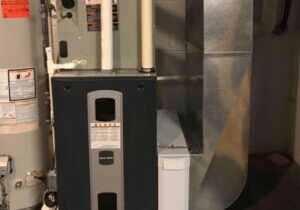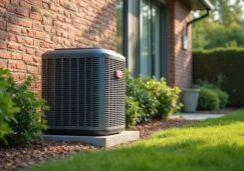In-floor heating is one of the most appealing types of heating systems. What is the reason for this? How does an in-floor heating system work?
This system uses electrical wires or hot water pipes to generate heat from underneath the floor.
Since all components are underneath the floor, in-floor heating takes up less space than forced-air heating. As a result, it cannot be seen! Though you won’t see it, you’ll feel its presence.
How In-Floor Heating Works
Water or electricity is embedded in the floor to heat rooms with in-floor heating. As the heat radiates from the floor, it’s absorbed by surrounding objects, which helps to warm the house.
Hydronic and electric in-floor heating systems are available.
Hydronic heating, known as hot water heating, circulates heated water through tubes installed throughout the house.
Electric in-floor heating utilizes electricity to generate heat and distributes it through thin wires installed directly under the floor.
Each in-floor heating system has its pros and cons. Hydronic heating, for instance, is better if you want to heat large areas in your home.
Due to their complexity, hydronic systems are more expensive to install. Hydroponics, however, is more durable. With proper maintenance, it can last for decades.
On the other hand, electric in-floor heating is more suitable for specific house areas. Additionally, they are less expensive and easier to install. Your heating bill will be higher if you use electric heating since it consumes more energy.
Basic Knowledge of the Installation Process
The installation process for both types of underfloor heating is similar, with parts embedded underneath the floor. Hydronic heating installation, however, is more complex than electrical heating, which is more of a DIY project. As a result, you will need to hire a professional.
Subfloors are required for both types of in-floor heating. For this reason, you’ll likely need to replace your existing flooring with a new one, especially if the material isn’t heat-resistant.
If you want a floor that conducts heat well, choose tiles, vinyl, laminates, or hardwood nailed to the subfloor.
In-Floor Heating Has Several Advantages
Energy Efficient
Radiant floor heating uses less energy than baseboard or air-forced heating systems. The upfront costs are high, but you’ll save more in the long run.
Non-allergenic
As forced-air heating circulates air throughout the house, allergens can be distributed. Asthma and allergy sufferers can benefit from radiant flooring since it doesn’t move air around.
Very quiet
In-floor heating systems are almost silent. There are no furnaces at work here, so you don’t have to worry about unusual noises.
Uniform heating
Because in-floor heating heats the entire floor, it is better at heating the room evenly.
Vents distribute air with air-forced heating. Rooms with vents will therefore be warmer than those without.
End Note
The benefits of in-floor heating include its effectiveness, convenience, and cost-efficiency. It depends on your home’s size and the areas you want to heat. The upfront costs of installing in-floor heating can be high, but they can save more energy in the long run than conventional systems.
About Spurk HVAC
Spurk HVAC was founded in 2018 and is located in Warrendale, Pennsylvania. We proudly serve Cranberry Twp., Wexford, Gibsonia, Mars, and the surrounding areas. We are an American Standard Customer Care Dealer and a Mitsubishi Diamond Contractor. We service all makes and models. Please contact us if you are seeking heating repair, heating system replacement, air conditioner repair, air conditioning maintenance, air conditioning replacement, or any other heating & cooling services. Whether you are looking for residential or commercial HVAC services, we look forward to any opportunities to become your preferred HVAC contractor.










